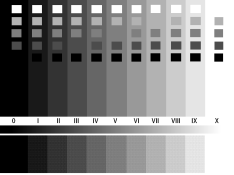I was trying to make my own gray-scale Wedge with 11 steps and decided to add a section where detail was present inside a zone.
for zone V i took the value of 127 -+ 12 and ended up creating a brick/mortar pattern. I haven't tested this on film yet, but it seems that detail for darker zones seems clearer.
Is there a better way to do this pattern? maybe darker zones should have less variance from the middle value....
Thanks for any advice!
for zone V i took the value of 127 -+ 12 and ended up creating a brick/mortar pattern. I haven't tested this on film yet, but it seems that detail for darker zones seems clearer.
Is there a better way to do this pattern? maybe darker zones should have less variance from the middle value....
Thanks for any advice!











 ok
ok